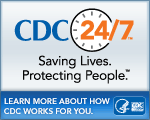State of CDC Archive
Strengthen Surveillance and Epidemiology
At CDC, rigorous surveillance and epidemiology are our most powerful tools. They form our approach and are the foundation of our authority. It is essential that we systematically collect, analyze, and interpret data in an ongoing way to better plan, implement, and evaluate public health programs. Just as important, though, is the need to share this information with those who want it and can use it. We are committed to collecting the right data to ensure that limited resources for public health interventions are used wisely, and CDC’s staff is skilled in developing systems to collect information to establish effective public health programs. This year, we look forward to celebrating the 50th anniversary of the National Health and Nutrition Examination Survey (NHANES), which assesses the health and nutritional status of adults and children in the United States by combining data from interviews and physical examinations.
2009

A Coal Miner’s Story
By reducing the risk of work-related illness, injury, and death among coal miners, we work with our partners to help communities and the economy stay healthy. CDC screened 1,310 coal miners at 18 locations in Kentucky, Pennsylvania, Tennessee, and West Virginia for early detection and prevention of coal workers’ pneumoconiosis— also known as black lung—a serious work-related respiratory disease associated with mining coal. Using a specially equipped, mobile screening van, we provided coal miners with free chest X-rays at locations designed to make the screening more available and convenient. Although advances have been made in reducing the incidence of coal workers’ pneumoconiosis, this often debilitating and deadly disease remains persistent among workers. Through education and early detection from screening we are able to promote a better quality of life.
Understanding How Environment Affects Health
Earlier this year, CDC launched the Web-based Environmental Public Health Tracking Network, a surveillance tool that scientists, health professionals, and the public can use to track environmental data and chronic health conditions. Currently, funding is available for tracking programs in 22 states and New York City. To date, these partnerships have led to 73 actions to prevent the population from possibly becoming ill from environmental exposures. Plans to expand the tracking network across all 50 states will help us and our partners form a more complete picture of how the manmade and natural environment affect health and what we can do to prevent related diseases.
Sharing Vital Health Statistics
The National Vital Statistics System is the oldest and most successful example of inter-governmental data sharing in public health. The relationships, standards, and procedures are important parts of how we collect and share the nation’s official vital statistics. These statistics are provided through registration systems that various jurisdictions use to gather these required data—births, deaths, marriages, divorces, and fetal deaths. The National Health Interview Survey, which provides the only health insurance data to CDC, off ers annual and trend data on health insurance in the United States.
2008
Controlling the Obesity Epidemic

CDC partnerships, innovative interventions, and new research findings in 2008 all contributed to the early signs of success in the prevention and control of obesity on both the state and national levels. From classrooms to living rooms, recent evidence indicates that obesity rates have hit a plateau—a critical first step in reversing the alarming trends that have been increasing since 1980.
For example, CDC surveys found no increase in obesity prevalence among women or men between 2003–2004 and 2005–2006. Evidence from the Youth Risk Behavior Surveillance System indicates that the prevalence of high body mass index (BMI) among children and adolescents has leveled off. CDC’s efforts have also helped to increase recognition of obesity as a national public health problem. From 2000–2006, the number of articles on obesity published in the national press increased from 2,000 to 6,000. Other important indicators include the substantial shifts in available school foods as documented by the 2006 School Policies and Programs Survey, and the large number of US communities mobilizing to address obesity prevention and control.
CDC is making inroads in the fight against obesity on numerous fronts:
Creating Innovative Partnerships. The Healthy Eating Active Living Convergence Partnership seeks to change policies and environments to better achieve the vision of Healthy People Living in Healthy Places. Its innovation lies in its focus on engaging people in fields not traditionally involved in public health. This partnership is currently focusing on two areas—transportation and food systems—as powerful leverage points to develop active living environments and improve access to healthy foods. In 2009, CDC will co-convene a Transportation and Public Health meeting and will co-sponsor a Food Systems and Public Health meeting. Partners include the California Endowment, Kaiser Permanente, Nemours, Robert Wood Johnson Foundation, W.K. Kellogg Foundation, PolicyLink, and Prevention Institute.
Convening National Leadership Activities. CDC is leading the development of the National Roadmap for Obesity Prevention and Control plan, expected in 2010. Two conferences that convened in 2008 were stepping stones for developing the Roadmap: The National Summit on Legal Preparedness for Obesity Prevention and Control, which focused on law-based strategies for obesity prevention and control; and The Community Approaches to Address Obesity Conference, which focused on understanding, reporting and disseminating successful community-level obesity interventions. These conferences laid the groundwork for the upcoming Weight of the Nation Conference, scheduled for summer 2009, which will highlight progress in obesity prevention and control and identify action needed to reverse the epidemic.
Advancing National Collaboration on Childhood Obesity Research (NCCOR). Initiated in 2008, NCCOR is helping to stem the epidemic by advancing coordination across research funding organizations. NCCOR benefits research, evaluation, translation, and dissemination efforts by accelerating the pace of research; reducing redundancy; ensuring focused initiatives in the areas of greatest need; and building capacity for multilevel, integrated research. NCCOR is developing a shared research agenda focused on priority areas for collaboration. To build momentum and achieve early impact, NCCOR is identifying initial projects while the long-term joint research agenda is being developed. Partners include the National Institutes of Health and the Robert Wood Johnson Foundation.
Developing the Measures Project. There is an absence of agreed-upon measures to assess the policy and environmental change strategies that communities are initiating in response to the obesity epidemic. The Measures Project is designated by CDC as state-of-the-art in community practice because it adds to the existing evidence base while simultaneously providing a tool for communities to focus their obesity efforts. Twenty-six promising policy and environmental change strategies, each with a single measure, have been identified. A web-based tool that local governments can use to assess performance on the 26 measures is being pilot tested by 20 communities. These communities will provide feedback on the feasibility and usefulness of the measures for local governments and policy makers at an end-users meeting in January 2009, after which it is expected that the measures will be disseminated and implemented nationwide.
Implementing Early Assessment of Programs and Policies to Prevent Childhood Obesity. This two-year collaboration identifies a set of local-level programs and policies to improve children’s eating habits and physical activity levels and determines which have been implemented with apparent success and which merit rigorous evaluation. This assessment prevents premature investment in evaluating programs and policies that have not been implemented adequately, allowing resources to be targeted to those evaluations most likely to fill important gaps in the evidence base for obesity prevention. Priority is placed on programs and policies implemented in community settings targeting children aged 3–17 years and addressing populations that disproportionately experience childhood obesity (e.g., low income; ethnic groups). Fourteen programs and policies have been deemed ready for immediate, full-scale evaluation, of which one (New York City Daycare Regulations) will undergo rigorous evaluation in late 2009.
Translating Research into Practice
CDC translates research findings for use by practitioners, communities, and the public:
- Lean for Life Web site. A synthesis of the science and practice-based evidence on worksite obesity interventions, this Web site guides companies in planning, building, promoting, and evaluating customized obesity prevention and control programs. Developed in direct response to organizations requesting help in addressing obesity, the Web site includes an obesity cost calculator that projects the cost of obesity for a company and their expected financial return from implementing a program.
- Swift Worksite Assessment and Translation. This evaluation method allows for rapid assessment of worksite health promotion programs that help employees attain or maintain a healthy body weight. The method generates data sufficient to identify promising and innovative worksite strategies for reducing adult obesity. New translation documents for this method include an implementation guide and site visit protocol documents; they are available on CDC’s Healthy Worksite Initiative Web site.
- The Weight Management Research to Practice Series. This series of documents summarizes the science on various weight management topics and highlights the implications of research findings for public health and medical care professionals. Some installments in the series have a companion brochure geared toward the general public. Five documents are completed covering the topics of fruits and vegetables, portion sizes, sugar-sweetened beverages, breastfeeding, and low-energy dense foods.
- Healthy Weight Web site. Launched in 2008, the Healthy Weight Web site was created using CDC’s trusted weight management science as the foundation. The Web site emphasizes that healthy weight loss is not just about a “diet” or “program” and provides consumers with credible information, relevant steps, and tools to help them achieve and maintain a healthy weight for a lifetime.
These activities promote CDC’s Health Protection Goals of Healthy People at Every Stage of Life and Healthy People in a Healthy World. For more information about these translation efforts, go to CDC’s obesity Web site at www.cdc.gov/nccdphp/dnpa/obesity/index.htm and click on “selected resources.”
Obesity Rates
Obesity rates for adults have doubled between 1980 and 2004, while obesity rates for children have nearly tripled. Sixteen percent of US children and more than a third of US adults—more than 72 million people—are obese. Increases in obesity have occurred among the entire population. However, the largest increases have occurred among children and minorities.
Diabetes Tracking and Prevention Shows Progress

CDC’s diabetes prevention and research activities made new strides in 2008. For the first time, estimates of diabetes rates became available at the county level for all of the United States. In response to these new estimates, state-based prevention programs are identifying and referring more prediabetic Americans into group-based lifestyle programs.
CDC is the only federal agency that develops national surveillance systems for diabetes incidence data. Previously, data were only available at the state level. In July 2008, estimates of diabetes rates became available in each county. These data are an important step toward addressing the burden of diabetes. Nationally, the data indicate increased diabetes rates in areas of the Southeast and Appalachia that have traditionally been recognized as being at higher risk for many chronic diseases, including cancer, heart disease, and stroke.
Recent clinical trials have established that moderate weight loss through exercise and healthy eating can reduce the risk for diabetes by nearly 60% for the estimated 57 million Americans with prediabetes. Interventions may be cost effective if the annual per-person cost can be reduced to $100–$200 and if the programs can maintain the quality standards established in the clinical trials. A CDC-funded primary prevention pilot in Minnesota recently documented an annual cost of $160 per participant for lifestyle interventions delivered in group settings. The estimated 5%–7% weight loss in these participants was consistent with results achieved in clinical trials and supports and sustains CDC’s Health Protection Goal of Healthy People in a Healthy World.
State-based diabetes prevention and control programs, under the auspices of CDC’s Diabetes Primary Prevention Initiative (DPPI), are demonstrating success in identifying individuals with prediabetes and referring them to lifestyle programs in group settings such as those at the YMCA. DPPI is achieving these results in populations that largely comprise the medically underserved. These efforts provide the foundation for translating primary prevention science into widespread and broad-based community practice.
Diabetes Snapshot
Diabetes is the seventh leading cause of death and the leading cause of adult blindness, kidney failure, and non-traumatic lower extremity amputation. Heart disease deaths are 2–4 times higher for adults with diabetes.
In the last 15 years, the number of people in the United States with diabetes has more than doubled, reaching nearly 24 million Americans.
In addition to diabetes, 57 million US adults have prediabetes—elevated blood glucose levels not yet high enough to be classified as diabetes. Prediabetes increases the chances of developing diabetes 10- to 15-fold.
The total cost of diabetes in the United States in 2007 was $174 billion, or 20% of total US health care costs.
2005 County Level Estimates of Diagnosed Diabetes in the United States
The prevalence of diagnosed diabetes by county was estimated using data from CDC's Behavioral Risk Factor Surveillance System (BRFSS) and data from the US Census Bureau’s Population Estimates Program. Three years of data are used to improve the precision of the year-specific county-level estimates of diagnosed diabetes estimates. For example, 2004, 2005, and 2006 were used for the 2005 estimate. We are currently working on the county-level estimates for 2006.
Map provided by the Centers for Disease Control and Prevention: National Diabetes Surveillance System. This map and additional information can be found online at www.cdc.gov/diabetes/statistics/index.htm, retrieved 12/15/2008.

New HIV Test Revises Epidemic Trends

Accurately tracking the HIV epidemic is essential to the nation’s HIV prevention efforts. Monitoring trends in new HIV infections has posed a major challenge, since the beginning of the epidemic, in part because many HIV infections are not diagnosed until years after they occur.
CDC has developed a new technology called serologic testing algorithm for recent HIV seroconversion (STARHS). CDC has applied this technology to develop the first national surveillance system of its kind that is based on direct measurement of new HIV infections. This system provides more precise estimates of HIV incidence (the annual number of new infections) than ever before, because it can more accurately distinguish recent from long-standing HIV infections.

Since CDC applied this advanced technology, the first estimates issued in August 2008 indicated that approximately 56,300 new HIV infections occurred in the United States in 2006. This figure is roughly 40% higher than CDC’s former estimate of 40,000 infections per year, which was based on limited data and less precise methods. A CDC historical trend analysis, also published in 2008, suggests that the number of new infections was likely never as low as the previous estimate of 40,000 and has been roughly stable overall since the late 1990s. The new estimate does not represent an actual increase in the number of new infections, but rather reflects the ability to more precisely measure new HIV infections. Accurate measurement of new HIV infections assists CDC’s efforts in educating people about emerging health threats.
The results also confirm that the impact of HIV remains greatest among gay and bisexual men of all races, as well as among African American men and women. In 2006, infection rates among African Americans were seven times as high as Caucasians and almost three times as high as Hispanics, a group that was also disproportionately affected.
This innovative laboratory test will help CDC track the estimated number of new HIV infections in the United States annually. Information gathered from both the surveillance system and the test will allow CDC to better monitor the current course of the epidemic, target prevention efforts where they are needed, and assess the impact of current prevention efforts.
More Immigrants Being Screened for Tuberculosis

Ever wonder if CDC has the authority to prevent infectious diseases from entering the United States? It does. In fact, CDC has recently rewritten the rules on how countries should screen and treat people with tuberculosis before they arrive in this country. This will result in states saving an estimated $2 million in 2009 alone.
Medical screening for tuberculosis is legally required before applicants for US immigration (both immigrants and refugees) can receive a visa and enter the United States. Because of CDC’s authority, CDC is working on programs to decrease illness and death among immigrants and refugees and to prevent diseases from entering the United States. These efforts include building a Domestic Refugee Health Program, implementing the Electronic Disease Notification (EDN) system, publishing revised tuberculosis technical instructions, and developing a Refugee Health Initiative.
The Domestic Refugee Health Program assists refugees with the health aspects of resettlement and provides recommendations to physicians for post-arrival health assessments and preventive health interventions. This program also works with health departments to better understand the health problems that refugees face after arrival. The long-term goal of the Domestic Refugee Health Program is the standardization of medical services for refugees.
A long-term initiative now reaching maturity is EDN, an electronic, secure web-based system for notifying health departments of the arrival of immigrants and refugees. This system ensures that refugees receive a prompt post-arrival medical evaluation. As of October 1, 2008, the more cost-efficient EDN replaced the nationwide, slower, hard-copy notification system that depended on the mail service. All 50 states are receiving notifications through EDN.

In addition, CDC modernized the tuberculosis technical instructions used to screen overseas applicants for US immigration in 2007. The revised instructions identify additional tuberculosis cases by incorporating modern diagnostic testing and addressing appropriate treatment prior to arrival in the United States. By the end of Fiscal Year 2008, 28% of US-bound immigrants were screened for tuberculosis.
Implementing the revised instructions is anticipated to result in three times as many cases of tuberculosis being detected overseas and treated prior to arrival in the United States, allowing for diagnosis and treatment to occur prior to foreign-born persons entering the country. The decreased burden of diagnosis and treatment in the United States will lead to an estimated annual cost savings that will reach into the tens of millions, providing leadership in the global effort to control tuberculosis. This work supports CDC’s Health Protection Goal of People Prepared for Emerging Health Threats.
Additional information about the 2007 tuberculosis technical instructions and a listing of populations being screened can be found online at www.cdc.gov/ncidod/dq/panel_2007.htm.
Innovations in Medicine Safety

Medicines are used to heal, but they can sometimes cause harm when not used correctly. A recent CDC study has shown that adverse drug events cause more than 700,000 emergency department visits each year.
CDC partners with other federal agencies to measure, understand, and prevent harm from medicines, especially for the most vulnerable Americans—children and older adults. CDC, with the US Food and Drug Administration (FDA), joined together with the US Consumer Product Safety Commission to enhance the existing National Electronic Injury Surveillance System: Cooperative Adverse Drug Events Surveillance system (NEISS-CADES). This system tracks adverse drug events such as allergic reactions, side effects, and unintentional overdoses, supporting CDC’s efforts to protect people in every stage of life.
CDC’s innovation in national health monitoring using the NEISS-CADES system and collaborations with other federal agencies recently identified high rates of emergency visits for overdoses from cough and cold medicines among young children. FDA and the manufacturers of these products now recommend that these medicines should not be taken by children less than four years old. CDC and FDA are working together to ensure that parents and physicians are aware of these new recommendations which may prevent thousands of emergency department visits each year.
In 2008, CDC also used the NEISS-CADES system to find that just three drugs (insulin, warfarin, and digoxin) caused one in three emergency department visits related to medications among older adults. FDA, the Health Resources and Services Administration, and nongovernmental organizations are now using this information to focus and prioritize medication safety efforts to keep people healthy. CDC data also found that antibiotics were seven of the top 15 medicines implicated in emergency visits for adverse drug events. CDC has been working to reduce inappropriate use of antibiotics to address the emerging threat of antimicrobial resistance.
Hearing Initiative Triples Screening for Infants
Strong partnerships and collaborations with other federal agencies, states and territories, as well as several professional organizations are responsible for the remarkable success of CDC’s Early Hearing Detection and Intervention program. At the program’s inception, fewer than 30% of infants in the United States were being screened for hearing loss, compared to more than 92% today.
This program is a national initiative that supports the early identification of infant hearing loss through screening, audiological diagnosis, medical evaluation, and enrollment in early intervention services. More than 12,000 babies are born in the United States with hearing loss every year. Prior to this program, the average age of diagnosis of hearing loss in infants and young children ranged from 14 months to around three years of age. Now, many infants are diagnosed before three months of age. With screening and early intervention, estimates show a reduction of $44,220 per child in lifetime educational costs for children with permanent bilateral hearing loss—a potential savings of approximately $200 million annually.
Birth Defects Prevention Study
In 2008, CDC’s National Birth Defects Prevention Study provided further evidence that smoking and diabetes in women are harmful to unborn babies by contributing to major, structural birth defects.
Women who have diabetes before they become pregnant are three to four times more likely to have a child with one or even multiple birth defects than a mother who is not diabetic. Also, women who smoke early in their pregnancy are more likely to give birth to infants with congenital heart defects and orofacial clefts. These findings have significant public health implications because nearly three percent of all infants born in the United States have a major birth defect, and nearly one percent have a congenital heart defect.
CDC’s National Birth Defects Prevention Study is the largest population-based study on the causes of birth defects ever undertaken in the United States.
2007
Links Between Birth Defects and Depression Treatment
For the last decade, CDC has been working on the largest study ever undertaken in the United States on the causes of birth defects. Researchers have gathered information from more than 25,000 participants and are using this information to look at key questions on potential causes. Recently, scientists have examined the use of certain antidepressants— selective serotonin-reuptake inhibitors most commonly known as SSRIs—during pregnancy and have found that they do not significantly increase the risk for most birth defects. As well, the study found no significant increase in the risks for the majority of birth defects assessed when all SSRIs were studied together. This finding includes the risk for congenital heart defects, which were associated with SSRI use in previous studies. Researchers, did, however, find associations between SSRI use and three specific birth defects: a defect of the brain, one type of abnormal skull development, and a gastrointestinal abnormality.
Vaccine Protection Campaign
In FY07, CDC launched a campaign to encourage parents to vaccinate their preteens against serious, sometimes life-threatening diseases. The CDC’s Preteen Vaccine campaign is designed to inform parents, caregivers, family physicians and pediatricians about CDC’s new vaccination recommendations for 11- and 12-year-olds. The three preteen vaccines are MCV4, which protects against meningitis and its complications; Tdap, a booster against tetanus, diphtheria, and pertussis or “whooping cough”; and Gardasil®, a newly approved human papillomavirus (HPV) vaccine for females that protects against the types of HPV which most commonly cause cervical cancer. CDC recommends the use of HPV for girls and women to help prevent cervical cancers and other diseases caused by certain types of genital HPV. Gardasil® protects against four HPV types, which together cause 70% of cervical cancers and 90% of genital warts. Information on CDC’s Web site features easy-to-understand, downloadable educational materials in English and Spanish. See www.cdc.gov/vaccines/preteen.
CDC Detection Networks Stop Salmonella Outbreaks in their Tracks

With more than 40,000 cases of Salmonellosis reported in the United States each year, CDC searches for ways to improve its ability to detect, report, and contain foodborne outbreaks. Last year brought many successes in these areas, including a new molecular typing system that provides a faster, easier, and more reliable method of identifying Salmonella species.
Two powerful information tools—PulseNet and OutbreakNet—worked hand-in-hand to stop several serious outbreaks of food poisoning in FY07. OutbreakNet is a network of public health epidemiologists at the local, state and federal levels who investigate foodborne and diarrheal disease outbreaks. PulseNet is the revolutionary national surveillance system coordinated by CDC that allows public health laboratories to exchange information on foodborne bacteria “DNA fingerprint” patterns.
Like detectives searching for invisible clues, the networks used DNA sampling to identify several diarrheal illnesses caused by a rare strain of Salmonella in several states and strongly linked to a puffed rice and corn snack food with a vegetable coating. CDC reported that these illnesses were caused by Salmonella Wandsworth, a strain that had never before caused an outbreak of illness in the United States. After being informed about the outbreak investigation, the company that markets the product issued a voluntary recall.
A similar multistate outbreak—this time a Salmonella serotype called Schwarzengrund—was linked to dry pet food at a single manufacturing facility in Pennsylvania. As of September 2007, 62 persons in 18 states became ill after contact with the pet food, and one quarter of them required hospitalization. The company recalled the pet food, and CDC investigators are still studying why human illness, especially among infants, is associated with dry pet food.
A third large outbreak—Salmonella Tennessee—was linked to a peanut butter plant in Georgia. A total of 425 persons were infected in 44 states, with 20% requiring hospitalization.
Critical to the success in controlling Salmonella outbreaks is fast, reliable detection. CDC scientists made a breakthrough in FY07 by developing and validating a new molecular typing system. The new system is not only faster and more reliable than classical serotyping for Salmonella species, it also is easier to use. The system is poised to replace existing technology in state public health laboratories in the near future.
Salmonellosis is an infection with bacteria called Salmonella. Most persons infected with Salmonella develop diarrhea, fever, and abdominal cramps 12 to 72 hours after infection. The illness usually lasts 4 to 7 days, and most persons recover without treatment. However, some persons have such severe diarrhea that they need to be hospitalized.
Infrastructure Health Preparedness Readies for Climate Change

With the earth’s climate projected to undergo significant changes, CDC is pioneering new ways to understand, measure, and respond to the impact of environmental hazards on human health to help ensure healthy places for us to live, work, and play. These efforts include new tracking systems, better modeling, increased surveillance, and innovative research. CDC also is developing the first-ever conceptual framework for public health actions in response to global climate change. Many of its existing programs and scientific expertise provide a solid foundation for responding to climate-related environmental hazards. Here are several areas where CDC is investing in climate change preparedness.
Environmental Public Health Tracking: CDC’s National Environmental Public Health Tracking Program has funded several states to build a health surveillance system that integrates environmental exposures and human health outcomes. Beginning in 2008, the Tracking Network will provide information on how health is affected by environmental hazards. The Network will contain critical data on the incidence, trends, and potential outbreaks of diseases, particularly those impacted by climate change.
Disease Surveillance: Preparing for climate change also involves working closely with state and local partners to document whether potential changes in climate have an impact on diseases transmitted through water, food, insects and animals. One such development is ArboNet, the national arthropod-borne viral disease tracking system. Currently, this system supports the nationwide West Nile virus surveillance system that maps cases in humans and animals, and would detect changes in real-time in the distribution and
prevalence of cases. CDC’s PulseNet tracking system also is uniquely designed to identify climate-related changes in the incidence of food- and water-borne diseases.
Geographic Information System (GIS): CDC is applying GIS technology in unique and powerful ways, including public health responses to environmental hazards. It has been used in data collection, mapping, and communication to respond to issues as wide-ranging and varied as the World Trade Center collapse, avian flu, SARS, and Rift Valley fever. In addition, GIS technology was used to map issues of importance during the CDC response to Hurricane Katrina.
Modeling: Model projections of future climate change can be used as inputs for models that assess the impact of climate change on public health. For example, CDC has conducted heat stroke modeling for Philadelphia to predict the most vulnerable populations at risk for hyperthermia.
Health Protection Research: CDC promotes research to further study the specific relationships between climate change and health outcomes, including predictive models and evaluations of interventions.
CDC Checks for Dangers from Emerging Technologies

Nanotechnology is a rapidly expanding and highly diverse field that includes in general terms engineered structures, devices and systems that have an extremely small length scale of 1 – 100 nanometers; a nanometer is a metric unit of length equal to one billionth of a meter. At these length scales, materials begin to exhibit unique properties that affect physical, chemical and biological behavior. Researching, developing and utilizing these properties are at the heart of the new technology.
Nanoparticles, which are one of the building blocks of nanotechnology, are one reason that CDC is taking a closer look at this new industry. Because of concerns that workers exposed to engineered nanoparticles could be at an increased risk for adverse health affects, CDC is conducting research and providing guidance on the occupational safety and health implications and applications of nanotechnology.
This research is on the cutting edge of science and health. Over the last year, CDC has provided interim guidance for controlling exposures while needed research progresses and offered informational resources and technical assistance not available elsewhere. CDC is a model for excellent science and scientific partnership on this emerging technology.
Over the last fiscal year, CDC
- Issued draft interim guidance, “NIOSH Current Intelligence Bulletin,” on medical screening of workers potentially exposed to nanoparticles in the production and industrial use of nanomaterials to ensure early detection of workplace exposures and conditions that may pose occupational health risks.
- Conducted 10 intensive on-site scientific evaluations of actual • nanotechnology processses in partnership with eight industrial, academic, military, and research organizations. At the sites, CDC scientists and engineers assessed potential exposures and operational experiences, control technologies, personal protective equipment, and work practices.
- Published the first progress report on the strategic research program since it began in 2003.
These and other efforts under the strategic research program are beingconducted to
- Determine whether nanoparticles and nanomaterials pose risks of injuries and illnesses for workers.
- Learn how to apply nanotechnology to the prevention of work-related injuries and illnesses.
- Promote healthy workplaces through interventions, recommendations, and capacity-building.
- Enhance global workplace safety and health through national and international collaborations on nanotechnology research and guidance.
Breaking New Ground in Genomics

Genomics is cutting edge science that provides a more comprehensive understanding of the risks for diseases and helps to strengthen disease prevention activities. During the past decade, CDC has helped establish public health genomics as a multidisciplinary field aimed to ensure effective and responsible translation of scientific discoveries in genetics and genomic applications into health practices for improving the public’s health.
CDC and its partners are integrating genomics into public health research, programs, and policy to help improve interventions that are designed to prevent and control the country’s leading chronic, infectious, environmental, and occupational diseases. CDC efforts include conducting population-based genomic research, assessing the role of family history in disease risk and prevention, and evaluating genetic tests.
CDC established the independent, nonfederal Evaluation of Genomic Applications in Practice and Prevention (EGAPP) Working Group in 2005 to support the development of a systematic process for evaluating genetic tests in clinical practice. Reliable, evidence-based information is needed to help determine which genetic tests are safe and effective and to provide guidance on their appropriate use.
In 2007, the EGAPP completed four CDC-funded reports through an interagency agreement with the Agency for Healthcare Research and Quality:
- Genomic Tests for Ovarian Cancer Detection and Management;
- Testing for Cytochrome P450 (CYP450) Polymorphisms in Adults With Non-Psychotic Depression Treated With Selective Serotonin Reuptake Inhibitors;
- Hereditary Nonpolyposis Colorectal Cancer: Diagnostic Strategies
- and Their Implications; and Impact of Gene Expression Profiling Tests on Breast Cancer Outcomes.
In December 2007, the EGAPP Working Group released the first in a series of recommendation statements that address the use of cytochrome P450 testing in adults with depression who are beginning treatment with a widely prescribed class of antidepressants.
CDC also completed an analysis of data collected through CDC’s National Health and Nutrition Examination Survey to assess the risk of common chronic diseases and conditions in the U.S. population that can be attributed to family health history. CDC found that family history of diabetes has a significant, independent, and graded association with the prevalence of diabetes. People with a family history that puts them in the moderate- or high-risk categories for diabetes were, respectively, 2.3 and 5.5 times more likely to have diabetes than were people in the average risk category. This risk was independent of a person’s gender, race/ethnicity, age, body mass index, hypertension, income, or education.
The study of genomics at CDC is critical to the future of health protection and care through its potential to lead to new and better ways to improve health and prevent diseases for individuals and populations.
Contact Us:
- Centers for Disease Control and Prevention
1600 Clifton Rd
Atlanta, GA 30333 - 800-CDC-INFO
(800-232-4636)
TTY: (888) 232-6348 - cdcinfo@cdc.gov



